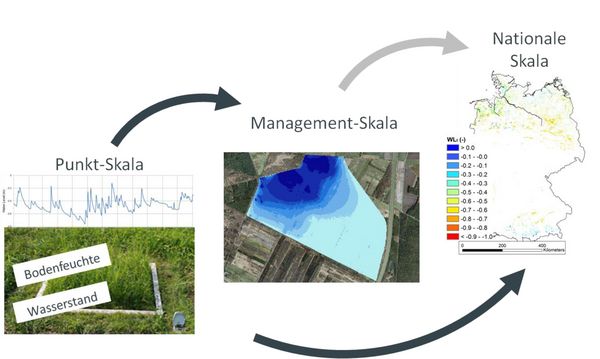Expertise
Modelling the Hydrology of Organic Soils
Bärbel Tiemeyer | 30.06.2022
Hydrological processes have a decisive influence on the greenhouse gas and nutrient dynamics of organic soils. Hydrological modelling serves to answer these types of questions.
Hydrological processes have a decisive influence on the greenhouse gas and nutrient dynamics of organic soils. To what extent can greenhouse gas emissions be reduced in a project area with certain water management measures? How do the hydrological dynamics and the nutrient losses change in this case? How does climate change affect the water levels in peatlands? Hydrological modelling serves to answer these types of questions.
Through our work it becomes clear that there are complex systematic interactions between soil moisture and water level dynamics and biogeochemical processes.
The development of reliable, large scale hydrological models is a great challenge and the topic of international research activities. Organic soils have, until now, been rarely included. In laboratory experiments we therefore study whether the model approaches for mineral soils can also be applied to organic soils (Article in Journal of Hydrology). With field data, we quantify the evapotranspiration from peatlands and develop simple methods to determine the hydraulic characteristics of organic soils (Article in Vadose Zone Journal). With these basics we develop models on a large scale. Applying a hydrological model for a re-wetting project we have, for example, accompanied running measures and estimated their impact. With scenario simulation we could find an optimum greenhouse gas balance at the project scale, which, in contrast to normal practice, was surprisingly predicted for very wet conditions with a great portion of flooded areas.
Furthermore we were able to create the first comprehensive data base on peatland groundwater levels with the help of many natural protection associations, agencies and academic institutions. On the basis of this dataset we created the first German-wide groundwater level map of organic soils (Article in Hydrology and Earth System Sciences). It is an important basis for various subsequent studies including the national emission reporting.
With the integration of remote sensing data into hydrological models we hope to improve the precision and temporal resolution of the groundwater level maps in the future. We are striving to create a similar data collection and modeling process on the European level.


![[Translate to English:] Logo des Bundesministerium für Ernährung und Landwirtschaft](/media/allgemein/logos/BMEL_Logo.svg)